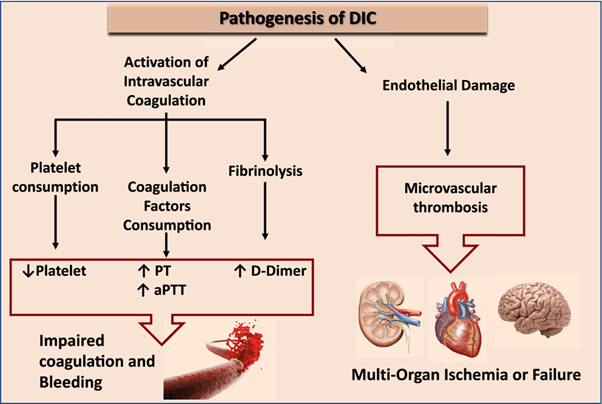How does the emergency department nurse caring for a critically ill with septic shock recognize that severe tissue hypoxia is present?
Partial thromboplastin time 64 seconds
Lactate 9.0 mmol/L
Potassium 2.8 mEq/L (2.8 mmol/L)
PaCO2 58 mm Hg
The Correct Answer is B
Lactate is a by-product of anaerobic metabolism that accumulates when there is insufficient oxygen supply to meet cellular metabolic demands. In the context of severe tissue hypoxia, such as in septic shock, the body may resort to anaerobic metabolism, leading to increased lactate production and elevated lactate levels in the blood.
Elevated lactate levels, typically above 4.0 mmol/L, are indicative of tissue hypoxia and inadequate oxygenation at the cellular level. Higher lactate levels, such as 9.0 mmol/L, suggest more severe tissue hypoxia and increased anaerobic metabolism.
A. Partial thromboplastin time (PTT) 64 seconds in (option A) is incorrect because: PTT is a laboratory test that evaluates the intrinsic pathway of the coagulation cascade. While coagulation abnormalities may occur in septic shock, PTT alone does not specifically indicate severe tissue hypoxia.
C. Potassium 2.8 mEq/L (2.8 mmol/L) (option C) is incorrect because Low potassium levels (hypokalemia) can be a concern in septic shock, but it does not directly indicate severe tissue hypoxia.
D. PaCO2 58 mm Hg in (option D) is incorrect because: PaCO2 refers to the partial pressure of carbon dioxide in arterial blood and is a measure of the respiratory status. While an elevated PaCO2 can be a sign of respiratory acidosis, it is not specific to severe tissue hypoxia.
Therefore, in a critically ill patient with septic shock, an elevated lactate level, such as 9.0 mmol/L, indicates severe tissue hypoxia and inadequate oxygenation at the cellular level
Nursing Test Bank
Naxlex Comprehensive Predictor Exams
Related Questions
Correct Answer is D
Explanation
Arterial pressure monitoring involves the insertion of an arterial catheter, typically in the radial artery, to directly measure blood pressure. Complications can arise from this invasive procedure, and one potential complication is inadequate blood flow to the hand, leading to numbness or ischemia.
A. The Allen's test is positive in (option A) is incorrect because The Allen's test is performed before arterial catheter insertion to assess the collateral circulation of the hand. A positive Allen test indicates adequate collateral circulation, which is desirable before performing the procedure. However, it does not directly indicate a complication during or after arterial pressure monitoring.
B. The mean arterial pressure (MAP) is 90 mm Hg in (option B) is incorrect because The mean arterial pressure (MAP) represents the average pressure in the arterial system during one cardiac cycle. While changes in MAP can be significant for patient management, it does not specifically indicate a complication of arterial pressure monitoring.
C. The dicrotic notch visible in the waveform in (option C) is incorrect because The dicrotic notch represents the closure of the aortic valve and is a normal finding in arterial waveforms. Its presence does not indicate a complication.
Correct Answer is A
Explanation
Disseminated intravascular coagulation (DIC) is a condition characterized by both widespread activation of the coagulation system and excessive clotting, leading to the consumption of clotting factors and platelets. This results in a prothrombotic state, which can lead to organ dysfunction and bleeding manifestations.
Elevated D-dimer levels are a characteristic finding in DIC. D-dimer is a fibrin degradation product that is elevated when there is excessive fibrin formation and breakdown. Elevated D-dimer indicates ongoing fibrinolysis and activation of the clotting system.
B. Decreased prothrombin time in (option B) is incorrect because: DIC is characterized by consumption of clotting factors, which can result in prolongation of the prothrombin time (PT) as well as other coagulation tests.
C. Decreased partial thromboplastin time in (option C) is incorrect because Similar to the prothrombin time, the partial thromboplastin time (PTT) can also be prolonged in DIC due to the consumption of clotting factors.
D. Elevated fibrinogen level in (option D) is incorrect because, In DIC, there is consumption of fibrinogen along with other clotting factors. Therefore, elevated fibrinogen levels are not consistent with the pathophysiology of DIC.

Whether you are a student looking to ace your exams or a practicing nurse seeking to enhance your expertise , our nursing education contents will empower you with the confidence and competence to make a difference in the lives of patients and become a respected leader in the healthcare field.
Visit Naxlex, invest in your future and unlock endless possibilities with our unparalleled nursing education contents today
Report Wrong Answer on the Current Question
Do you disagree with the answer? If yes, what is your expected answer? Explain.
Kindly be descriptive with the issue you are facing.
